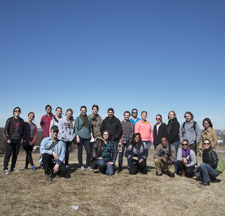Bringing the Green Back
UMBC students and faculty collaborate with a Baltimore community to make a lasting impact.
When Nicole King moved to Baltimore in 2008, she wasnt very familiar with the city. Six years later, shes developed deep connections within local communities. Firmly grounded in the Brooklyn-Curtis Bay (Baybrook) neighborhood, her classPreserving Places, Making Spaces in Baltimoreteaches social entrepreneurship, civic engagement and environmental justice.
King, an associate professor of American studies, was intrigued when she met Steve Bradley at a visual storytelling workshop several years ago. Bradley, an associate professor of visual arts, had spent time conducting research in Rotterdam. He was struck by the citys industrial landscape and similarities he saw with some Baltimore neighborhoods.
I had become interested in thinking more about how people perceive their place through their stories, and that resonated with Nicole, reflects Bradley. I didnt have any idea that Id become interested in cultural history, but this has been quite rich for me as an artist.
Bradley and Kings shared interest grew into a teaching collaboration where students connect artistic and historical inquiry to both explore and serve the needs of the Baybrook community. This work led to Mapping Baybrook, a project that uses digital mapping and visualization techniques to document and preserve the areas history through interactive multimedia formats.
This semester, Bradleys Imaging Research Center fellows and Kings Preserving Places students have spent countless hours attending community meetings, park cleanups, citizen-on-patrol walks and community gardening events. Their work is fundamentally about building community relationships, but it also has several specific goals related to environmental justice and business development. They have a special focus on the Filbert Street Community Garden, a conservation project, educational space and food farm in Curtis Bay.
The students are literally getting their hands dirty. A couple of weeks ago, we were in the garden planting fruit trees and working with the community gardeners, says King. That space will always be a part of who they are. I think you have a certain investment in a project that is beyond the investment that you would have in a class. Its not just about skills, its about learning how to make things work.
King and Bradley acknowledge it has taken time to build relationships with the community, but trust is growing between the students and residents. The more the students learn about Baybrooks vibrant cultural history, the more they understand, respect and value local residents, and the better they can research and relate those residents experiences.
Here, community engagement isnt an added chore or unexpected benefit on top of coursework, it is the point of the work. The students show up to things that they dont have to show up to all the time, says King. They see this as a connection to a larger project.
This week, WEAAs The Marc Steiner Show has been sharing the voices of Baybrook and Sparrows Point residents through a powerful radio series. The segments, produced by Bradley and Kings students, examine the processes and impacts of deindustrialization in the greater Baltimore region. Bradley, King, Bill Shewbridge (media and communication studies) and Michelle Stefano (American studies) have played major roles in stewarding the project and mentoring the student producers. The finished product segments featuring a mosaic of community voices alongside student voices describing the projects goals and approach speaks to the value of community engagement in both teaching and research.
King and Bradleys collaboration is supported by seed money from a Kauffman Faculty Innovation Grant and UMBCs BreakingGround initiative. The students semester of work will culminate on May 18 at the Garden Gala: Bringing the Green Back to Filbert Street. Through this public fundraising event, they hope to support a dedicated manager for the Filbert Street Community Garden, making a tangible, lasting impact.
This is really about building community, says Bradley. This is a viable place.
Homepage image: Curtis Avenue mural documenting cultural history, painted by Peggy Ward.
Photo courtesy Steve Bradley.
(05/14/2014)

